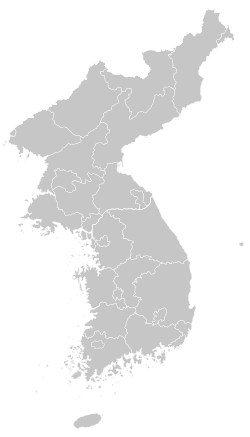Yeoncheon County
County in Sudogwon, South Korea From Wikipedia, the free encyclopedia
Yeoncheon County (Yeoncheon-gun) is a county in Gyeonggi Province, South Korea. The county seat is Yeoncheon-eup (연천읍) and sits on Gyeongwon Line, the Korail railroad line connecting Seoul, South Korea (ROK), with North Korea (DPRK).
Yeoncheon
연천군 | |
|---|---|
| Korean transcription(s) | |
| • Hangul | 연천군 |
| • Hanja | 漣川郡 |
| • Revised Romanization | Yeoncheon-gun |
| • McCune-Reischauer | Yŏnch'ŏn-gun |
 Location in Gyeonggi Province | |
| Coordinates: 38°06′N 127°05′E | |
| Country | South Korea |
| Region | Sudogwon |
| Administrative divisions | 2 eup, 8 myeon |
| Area | |
• Total | 675.22 km2 (260.70 sq mi) |
| Population (September 2024[1]) | |
• Total | 40,894 |
| • Density | 61/km2 (160/sq mi) |
| • Dialect | Seoul |
History
A variety of Paleolithic relics have been discovered at Jeongok-ri, first in 1978.[2][3] Since 1993 the Yeoncheon Jeongok-ri Paleolithic Festival has celebrated the discovery.[4]
Yeoncheon was the site of the Battle of Yultong during the Korean War, where the Philippine 10th Battalion Combat Team defended their position during the First Chinese Spring Offensive.
In August 2015, over 100 civilians were evacuated from the area after North and South Korea exchanged artillery fire.[5][6]
Administrative districts
The city is divided into two eup (towns) and eight myeon (townships):
| Town/Township | Hanja | Population[7] | Households |
| Yeoncheon-eup | 漣川邑 | 6,707 | 3,100 |
| Jeongok-eup | 全谷邑 | 20,872 | 8,522 |
| Gunnam-myeon | 郡南面 | 3,549 | 1,704 |
| Cheongsan-myeon | 靑山面 | 4,606 | 2,333 |
| Baekhak-myeon | 百鶴面 | 2,857 | 1,263 |
| Misan-myeon | 嵋山面 | 1,755 | 845 |
| Wangjing-myeon | 旺澄面 | 1,155 | 579 |
| Sinseo-myeon | 新西面 | 3,268 | 1,707 |
| Jung-myeon | 中面 | 261 | 145 |
| Jangnam-myeon | 長南面 | 678 | 307 |
Climate
Yeoncheon has a monsoon-influenced humid continental climate (Köppen: Dwa) with cold, dry winters and hot, rainy summers.
| Climate data for Yeoncheon (1999–2020 normals) | |||||||||||||
|---|---|---|---|---|---|---|---|---|---|---|---|---|---|
| Month | Jan | Feb | Mar | Apr | May | Jun | Jul | Aug | Sep | Oct | Nov | Dec | Year |
| Mean daily maximum °C (°F) | 1.8 (35.2) |
5.1 (41.2) |
11.5 (52.7) |
18.7 (65.7) |
24.6 (76.3) |
28.5 (83.3) |
29.8 (85.6) |
30.8 (87.4) |
26.6 (79.9) |
20.4 (68.7) |
11.6 (52.9) |
3.2 (37.8) |
17.7 (63.9) |
| Daily mean °C (°F) | −4.7 (23.5) |
−1.3 (29.7) |
4.8 (40.6) |
11.5 (52.7) |
17.6 (63.7) |
22.3 (72.1) |
25.0 (77.0) |
25.5 (77.9) |
20.3 (68.5) |
12.9 (55.2) |
5.3 (41.5) |
−2.6 (27.3) |
11.4 (52.5) |
| Mean daily minimum °C (°F) | −10.5 (13.1) |
−7.2 (19.0) |
−1.6 (29.1) |
4.6 (40.3) |
11.2 (52.2) |
17.0 (62.6) |
21.3 (70.3) |
21.5 (70.7) |
15.2 (59.4) |
6.9 (44.4) |
−0.2 (31.6) |
−7.8 (18.0) |
5.9 (42.6) |
| Average precipitation mm (inches) | 15.4 (0.61) |
22.7 (0.89) |
29.1 (1.15) |
61.5 (2.42) |
84.2 (3.31) |
112.1 (4.41) |
379.7 (14.95) |
346.6 (13.65) |
133.5 (5.26) |
52.9 (2.08) |
44.0 (1.73) |
14.1 (0.56) |
1,295.8 (51.02) |
| Average precipitation days (≥ 0.1 mm) | 3.1 | 3.9 | 5.7 | 7.4 | 7.0 | 8.8 | 14.5 | 12.9 | 7.1 | 5.5 | 6.9 | 5.0 | 87.8 |
| Source: Korea Meteorological Administration[8] | |||||||||||||
Sister cities
See also
References
External links
Wikiwand - on
Seamless Wikipedia browsing. On steroids.



